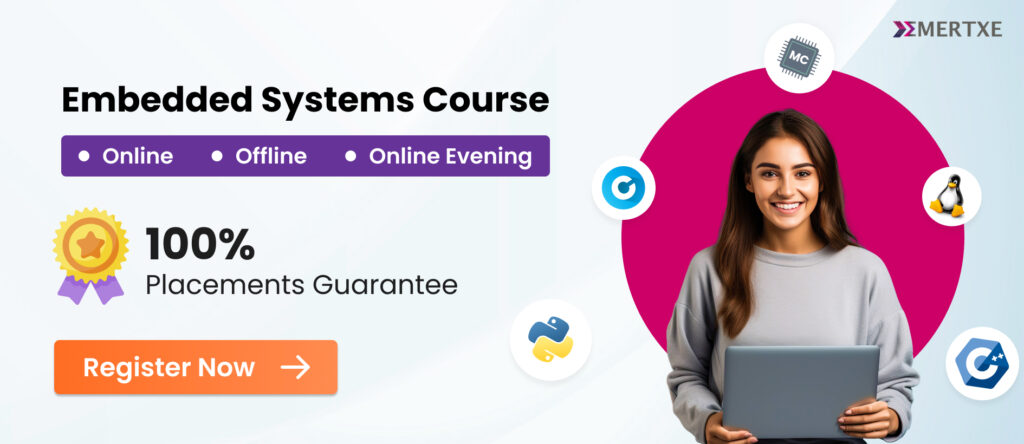Introduction
Emertxe is India’s leading EdTech company, offering embedded systems and Internet of Things(IoT) courses, training, and placements for engineering graduates. Emertxe was founded in 2003. Emertxe’s courses, training, and placements are always aligned with industry best practices, and the curriculum is continuously updated by skilled mentors and embedded systems professionals.
This blog goes into the core of Emertxe Learning Model, focusing on its T-shaped approach to embedded systems education. It explains the importance of this approach, explains Emertxe’s embedded systems curriculum, and showcases students’ outcomes and alignment with the industries’ needs.
A well-developed learning model is important for students’ success. As it offers a clear structure for developing students’ knowledge and skills. A strong learning model improves student engagement and learning outcomes, and provides students with the resources to succeed in their academic and professional lives. It’s the roadmap to successful learning.
By carefully considering these factors, Emertxe has developed a learning model that allows students to reach their full potential. Emertxe learning model is designed in sync with the industry’s ‘T’ shaped learning model, to give students a strong foundation in embedded systems.
Let us first understand what the ‘T’ shaped learning model is.
'T' Shaped Learning Model
The T-shaped learning model is a popular teaching and professional development strategy, particularly in fields where a broad and deep level of knowledge is required. This concept is represented by the letter “T”, where the horizontal line indicates breadth, as in a broad understanding of different areas, and the vertical line indicates depth, as in a deep knowledge of specific areas. T-shaped professionals are in high demand among industries due to their ability to combine deep skills with broad knowledge.
The T-shaped learning model benefits both individuals and companies. Companies can improve innovation, problem-solving, and adaptation by having staff with both breadth and depth of knowledge. T-shaped professionals are more flexible and improve team collaboration since they can interact well with colleagues from different backgrounds and thereby help in the company’s success.
Emertxe has carefully implemented the T-shaped learning model into its curriculum, offering students a broad understanding of system architecture along with deep experience in software design and programming, resulting in a strong foundation in embedded systems. At Emertxe, we believe that a successful embedded systems engineer must have an understanding of both the breadth and depth of the subject. Our T-shaped learning model reflects this concept, making sure that students get a broad understanding of embedded systems architecture while specializing in software design and programming.
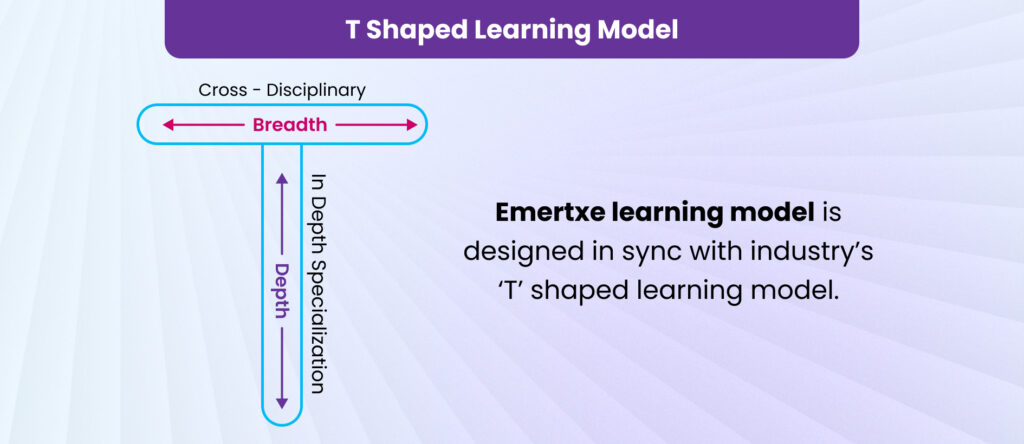
Embedded Architecture
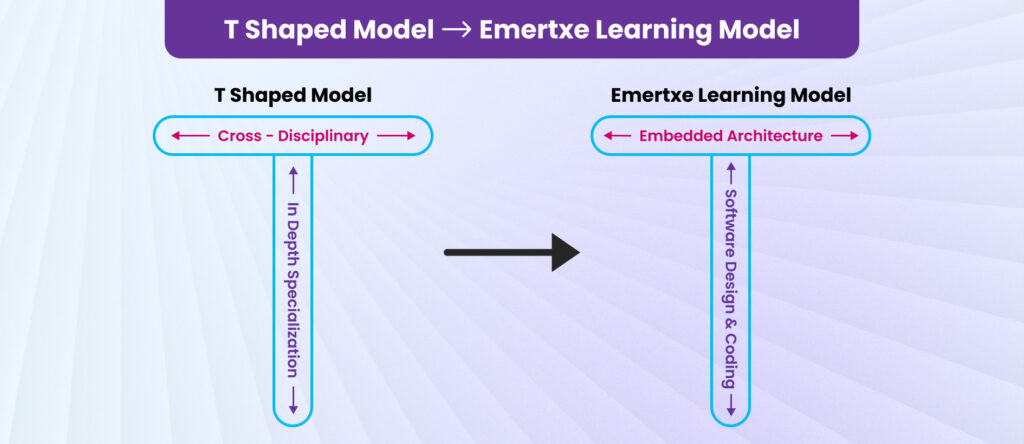
Embedded architecture is the foundation that describes embedded systems’ structure and functionality; that is how they look and act. It explains how the hardware and software components interact. A well-designed architecture ensures that embedded systems operate and function correctly, meet all their requirements, and are successfully built and deployed.
In the Emertxe Learning Model, a key focus is to provide students with an understanding of embedded architecture. This includes an overview of the different components of hardware and software that make up this architecture. By learning how microcontrollers, processors, memory, and peripheral devices interact with embedded software such as firmware, operating systems, and application code, students gain a broad view of embedded systems. This foundational knowledge is important for mastering the complexities of embedded systems design and development, ensuring students are well-equipped to build robust, effective, and scalable embedded solutions.
While hardware acts as the foundation for embedded systems, software is the engine that drives their functionality. Emertxe focuses on giving students a deep understanding of software design and programming principles. Let’s try to understand that part better
Software Design and Programming
Software design and programming is the fundamental component of successful embedded systems development. Software design acts as a blueprint guide for writing code that is dependable, efficient, and manageable. A well-designed software architecture improves resource consumption, scalability, and simplicity of modification. Software Programming is the code that defines the system’s behavior, interacts with hardware components, and its functionality.
By investing time and effort in effective software design and programming, embedded systems developers can create high-quality products that meet the demanding requirements of modern applications. Without well-written software, embedded systems would be nothing more than hardware without a purpose. In the end, strong software design and programming are what enable an embedded system to achieve its full potential, making them crucial components in successful embedded development.
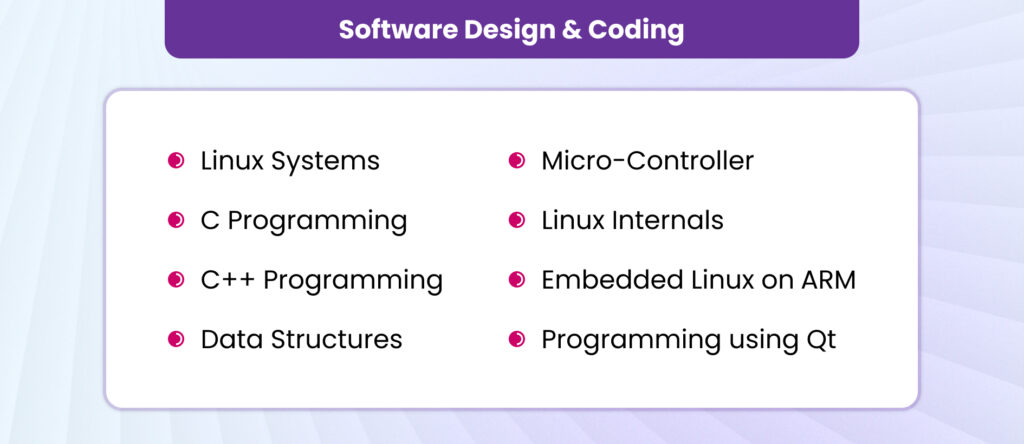
In the Emertxe Learning Model, the curriculum is carefully designed to provide a deep understanding of system design and programming. Key modules covered include:
Linux Systems: Linux is the standard OS for embedded systems development. This introductory module teaches Linux basics, essential commands, and tools like Vim. By the end of the module, students will be able to use powerful automation commands and efficiently set up your Linux platform for embedded development.
C/C++ Programming: Programming isn’t just about writing code; it’s about translating logic—our course bridges this gap, especially in today’s fast-paced industry. Master C programming, the foundation of embedded systems. Learn advanced C concepts and OOP features of C++ which includes Objects, Classes, Polymorphism, Inheritance, etc. to write efficient and scalable code.
Data Structures: A strong understanding of data structures is essential for writing efficient code. Learn about Abstract Data Types (ADTs) like Linked Lists, Stacks, Queues, and Trees, along with hashing, searching, and sorting techniques. This course provides hands-on practice and guides in selecting the best data structures for programs.
Micro-Controller: This phase marks the transition from C programmer to Embedded Programmer. Our micro-controller module focuses on developing embedded applications on microcontrollers without an OS. Learn to develop applications on physical boards and master communication protocols like UART, SPI, CAN, and I2C. Use the PICSimLab simulator for hands-on experience, even in our online courses.
Linux Internals: The Linux Internals course focuses on the important role of operating systems in modern embedded systems, driven by performance requirements and resource complexity. It offers developers a deep understanding of OS capabilities through system calls and provides hands-on experience with various Inter-Process Communication (IPC) mechanisms. This knowledge is required to manage and optimize embedded systems that rely on complex operating environments.
Embedded Linux on ARM: In this module, you will learn to create a customized Embedded Linux distribution and deploy it on ARM-based hardware. You will explore trends in Embedded OS and make informed open-source choices for your devices. This unique module combines previous lessons on Linux administration, hardware, the Linux OS, and C programming, bringing everything together for a comprehensive learning experience.
Programming using Qt: Qt is a lightweight, platform-independent framework ideal for developing high-quality GUIs with minimal code, making it perfect for embedded devices that require a GUI without running a full OS. In our Advanced Embedded Systems Course, you’ll use C++ with Qt to create GUIs for applications like Automotive Infotainment. Mastering Qt not only enhances your skill set but also strengthens your resume, paving the way for a long-term career in Embedded Systems Development.
As we can see, Emertxe’s curriculum is heavily focused on software design and programming, giving students the necessary skills and hands-on experience to excel in the embedded systems area. Emertxe prepares students to face complex challenges and achieve successful careers in embedded systems by balancing foundational knowledge and practical application.
Students Outcomes
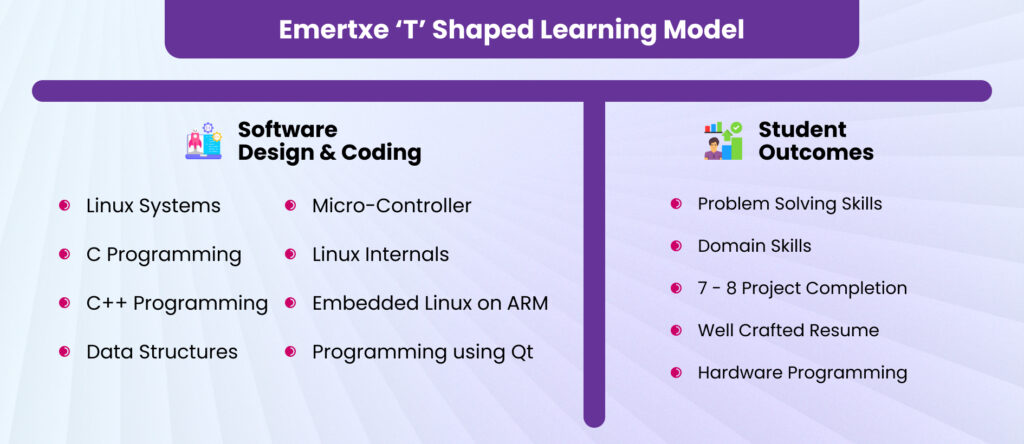
The Emertxe Learning Model’s challenging and industry-focused curriculum is directly linked with student performance. Emertxe assures that students learn embedded systems while also developing the confidence and ability to excel in their careers. Let us observe our students’ outcomes:
Improved problem solving skills and domain skills: At Emertxe, students develop strong problem-solving skills and deep domain knowledge through hands-on learning. Our curriculum challenges them with real-world scenarios, industry-relevant topics, and complex projects, strengthening analytical thinking, technical proficiency, and problem-solving skills. They also develop effective solutions and obtain a deep understanding of embedded systems concepts and best practices.
7-8 Project Completion: Students gain invaluable experience by completing an average of 7-8 projects during their course. These projects reflect actual industry challenges and cover a range of topics and technologies, allowing students to apply their theoretical knowledge in a real-world situation. By the end of the program, students have a resume of completed projects that demonstrate their capabilities and readiness for the professional world.
Well-Crafted Resume: We also focus on crafting well-developed resumes and guiding students in showcasing their skills, project experience, and achievements. By the end of the program, students have strong resumes that highlight their technical abilities and problem-solving skills, positioning them strongly in the job market.
Hardware Programming Skills: In addition to software skills, Emertxe’s curriculum prepares students with a solid understanding of hardware components, offering hands-on experience with various hardware platforms and teaching them how to use the software with hardware components. This skill set is crucial for roles involving embedded systems and IoT, making our students versatile and job-ready.
These outcomes highlight the impact of Emertxe’s learning model on our students’ careers and to make significant contributions in their fields.
Alignment of the Model with Industry Needs
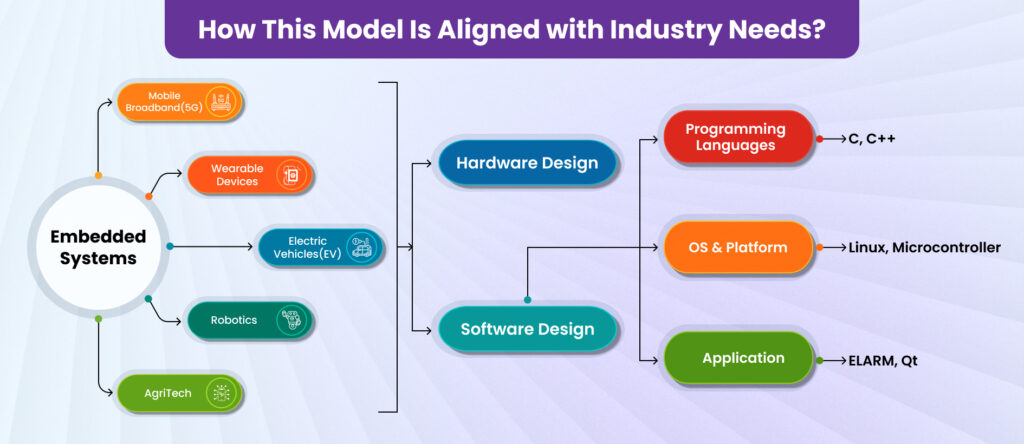
At Emertxe, our Learning model is thoroughly designed to align with the evolving demands of the industry, ensuring that our students are well-prepared for latest technologies that enable innovation and industry growth. Let us take a look at the sectors where embedded systems play a crucial role and are rapidly advancing and rely on both hardware and software components.
Mobile Broadband (5G): Embedded systems play a crucial role in enabling the smooth operation of 5G networks. Emertxe’s curriculum covers the necessary skills to contribute to the development of 5G-enabled devices and infrastructure. Students learn how to develop and customize hardware and software for high-speed, high-efficiency communication networks, for example: Designing embedded systems for 5G base stations, modems, and user equipment.
Wearable Devices: The growing popularity of wearable technology has increased the demand for skilled embedded systems engineers. Emertxe’s curriculum provides students with the knowledge and tools to design and develop innovative wearable devices, like integrating sensors and processors into wearable devices. Wearable technology, such as fitness trackers and smartwatches, requires accurate embedded systems to monitor health metrics and provide real-time data.
Electric Vehicles: In electric vehicles (EVs), embedded systems are essential for controlling everything from battery management systems (BMS) to motor control units (MCU). For example, Tesla’s Battery Management System (BMS) involves complex hardware design that includes high-voltage circuits and temperature sensors to monitor battery health. The software, developed in C/C++, manages battery charging and discharging cycles, ensuring the best performance and safety.
Robotics: Embedded systems are used in robotics for automation and control. For example, industrial robots used in manufacturing require hardware called actuators and sensors to interact with their environment. The software, which is typically developed in C/C++, controls the robot’s movements, processes sensor inputs, and enables decision-making in real time.
Agritech: In agritech, embedded systems are transforming traditional farming practices through smart farming solutions, drone-based agriculture, and IoT-enabled sensors for crop monitoring. For example, automated irrigation systems use soil moisture sensors (hardware) to determine when crops need watering. The software analyzes the sensor data and controls the irrigation system in real-time, improving water usage.
By aligning with these industry needs and providing a strong foundation in hardware and software expertise. Emertxe’s learning model empowers students to become highly demanded-professionals in these dynamic and rapidly evolving industries.
Conclusion
In conclusion, Emertxe’s learning model indicates our commitment to excellence in embedded systems education. By applying the T-shaped learning model, which focuses on both breadth and depth of knowledge, students gain a strong foundation in embedded architecture while mastering the complexity of software design and programming. Through a curriculum that covers everything from Linux systems and microcontrollers to advanced topics like embedded Linux on ARM and Qt, students are well-prepared for the challenges of modern embedded systems.
Finally, the success of Emertxe’s alumni in securing top positions across the industry reflects the effectiveness of this learning model. Join the Emertxe community and begin a journey of discovery and growth. Discover the transforming power of our learning model and unlock your full potential in the exciting world of embedded systems.
| Serial No | Related Blog Posts | Links |
|---|---|---|
| 1. | The Future Scope of Embedded Systems : Trends and Predictions | Click Here |
| 2. | Online Free IoT Internship for Engineering Students | Free Certificates |2023 | Click Here |
| 3. | Emertxe Placements in Embedded Systems and Embedded IoT – 2022 (Jan-sept) Report | Click Here |
People Also Ask(PAA)
Emertxe’s learning model stands out from traditional approaches with a T-shaped learning approach, by prioritizing practical application, industry alignment, thorough placement support, and a culture of continuous learning. This systematic approach provides students with the skills and knowledge necessary to succeed in embedded systems.
Emertxe ensures that its curriculum aligns with industry standards by continuously updating course content based on the latest technological advancements and industry needs. The curriculum is developed and modified by experienced professionals and mentors who have in-depth knowledge of the embedded systems field. This approach ensures that students are trained on the most up-to-date tools and technologies, making them industry-ready.
The Emertxe Learning Model focuses on software design since it has a direct impact on embedded systems efficiency, dependability, and performance. In embedded development, software design involves developing well-structured and maintainable code that can function effectively within hardware limits. Emertxe’s concentration on software design ensures that students learn how to write optimized code and solve complicated issues. This focus prepares students to face real-world difficulties in embedded systems, making them more competitive and more qualified to contribute to the industry.
